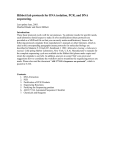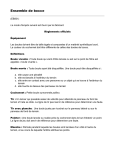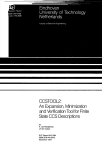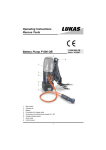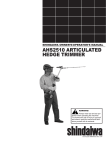Download Shindaiwa 68232-94011 Specifications
Transcript
SHINDAIWA OWNER’S/0PERATOR'S MANUAL EB501 BLOWER High Performance WARNING! Minimize the risk of injury to yourself and others! Read this manual and familiarize yourself with the contents. Always wear eye and hearing protection when operating this unit. Minimize the risk of injury: Read this manual and familiarize yourself with its contents. Part Number 68232-94011 Rev. 11/06 INTRODUCTION IMPORTANT! Before using this product, consult local regulations concerning noise restrictions and hours of operation! The Shindaiwa EB501 has been designed and built to deliver superior performance and reliability without compromise to quality, comfort, safety, or durability. Shindaiwa high performance engines represent the leading edge of 2-cycle engine technology, and deliver exceptionally high power at remarkably low displacement and weight. As a professional owner/operator, you’ll soon discover why Shindaiwa is simply in a class by itself! IMPORTANT! The information contained in this manual describes machines available at the time of production. While every attempt has been made to give you the very latest information about your Shindaiwa EB501 blower, there may be some differences between your machine and what is described here. Shindaiwa Inc. reserves the right to make changes in production without prior notice, and without obligation to make alterations to machines previously manufactured. CAUTION! The engine exhaust from this product contains chemicals known to the State of California to cause cancer, birth defects or other reproductive harm. 1 CONTENTS PAGE Attention Statements............................ 2 Nomenclature........................................ 3 Specifications......................................... 4 Assembling the Blower........................ 4 Mixing Fuel........................................... 6 Filling the Fuel Tank............................ 7 Starting and Stopping the Blower....... 8 Adjusting Engine Idle Speed.............. 10 Adjusting the Harness........................ 11 Using the Blower................................ 12 Routine Maintenance.......................... 13 Spark Arrester Maintenance............. 15 Storage................................................. 16 Troubleshooting Guide...................... 17 Emission System Warranty................ 21 CAUTION! This EB501 blower is equipped with a spark-arresting muffler! Never operate this machine without both the muffler and spark arrester installed and properly functioning! ATTENTION STATEMENTS This manual contains special “attention statements” surrounded by boxes and preceded by the triangular Attention Symbol. WARNING! A statement preceded by the word “WARNING” contains information that should be acted upon to prevent serious bodily injury. CAUTION! A statement preceded by the word “CAUTION” contains information that should be acted upon to prevent damaging your machine. Additional attention statements that are not preceded by the Attention Symbol are: IMPORTANT! A statement preceded by the word “IMPORTANT” is one that possesses special significance. NOTE: A statement preceded by the word “NOTE” contains information that is handy to know and may make your job easier. Read and follow this manual. Failure to do so could result in serious injury. Wear eye and hearing protection at all times during the operation of this machine. Do not operate this machine if you are tired, ill or under the influence of alcohol, drugs, or medicine. IMPORTANT! The operational procedures described in this manual are intended to help you get the most from your machine and also to protect you and others from harm. These procedures are general guidelines only, and are not intended to replace any safety rules/ laws that may be in force in your area. If you have any questions regarding your EB501 blower, or if you do not understand something in this manual, your Shindaiwa dealer will be glad to assist you. For additional information, you may also contact Shindaiwa Inc. at the address printed on the back of this manual. WARNING! Do not make unauthorized modifications to this machine! 2 NOMENCLATURE Volute Case Carburetor with Choke and Primer Spark Plug Air Cleaner Starter Handle Exhaust Outlet Throttle and Stop Lever Engine Cover Fuel Tank Fuel Filler Cap Handgrip 48002 90° Discharge Tube Figure 1 3 Flexible Tube Swivel Tube SPECIFICATIONS Model................................................................................................................... EB501 Dimensions (L x W x H)...............................................................330 x 375x 475 mm Engine Type.................... 2 cycle, catalyst, air cooled gas engine, vertical-cylinder Bore & Stroke.............................................................. 41 x 33 mm (1.6 x 1.3 inches) Displacement......................................................................... 43.6 cc (2.66 cu. inches) Fuel/oil ratio.............. Gasoline/oil mixture (50:1 with ISO EGD or JASO FC class 2- cycle EngineOil) Carburetor.............................................. Walbro diaphragm-type with primer pump Ignition......................................................... All transistor electronic ignition system Spark Plug...............................................................................................Champion CJ8 Starting..................................................................................................... Recoil starter Stopping.......................................................................... Throttle lever (fuel shut-off) Fuel Tank Capacity............................................................................2.1 liters (71 oz.) Exhaust System........................................................................ Spark-arrester muffler Air Filtration..............................................................................................Dry element Weight (dry; without blower tubes), EB501...................................... 8.6 kg (19 lbs.) Specifications are subject to change without notice. Prior to Assembly Before assembling, make sure you have all the components required for a complete unit: n Handgrip (removable) n 90° Discharge Tube n Three Tube Clamps (115 mm, 100 mm, 85 mm) See figure 2. n Flexible Tube Standard Tools n Swivel Tube n Spark Plug Wrench n Straight Tube n Three Hex Wrenches (3 mm, 4mm, 5mm) n Nozzle Tube ASSEMBLING THE BLOWER 1. Place the blower upright on the ground or a sturdy work surface. 2. Fit the 90° discharge tube over the blower outlet port, and secure with the 115mm dia. clamp. 3. Slip the flexible tube over the opposite end of the 90° discharge tube, and secure with the 100mm clamp. 4. Push the swivel tube into the flexible tube, and then install and tighten the 85mm clamp over the rotating band on the swivel tube. 5. Slide the handgrip over the swivel tube, and secure with the bolt, washer, and nut. 4 ASSEMBLING THE BLOWER (continued) 115mm Clamp Nut Swivel Tube Handgrip Bolt Washer 85mm Clamp 48002A 90° Discharge Tube 90° Discharge Tube Flexible Tube 100mm Clamp Handgrip Flexible Tube Swivel Tube Straight Tube Nozzle Tube 48003 Figure 2 6. Grasp the straight tube as shown, and push the tube over the swivel tube locking pins (right). See figure 3. Tube Assembly Align the lock pins with the lock slots, and push the tubes together. 7. Lock the straight tube to the swivel tube by rotating the straight tube. 8. Grasp the nozzle tube and lock the nozzle to the straight tube as in Steps 6 and 7. IMPORTANT! Blower tube installation affects blower balance and performance! Make sure the tubes and nozzle are correctly assembled per above, and that all connections are tight. 48004D Lock Pin Lock Slot Rotate clockwise to lock, making sure the 3 lines are aligned on both tubes. WARNING! Danger from rotating impeller! Stop the engine before installing or removing the blower tubes! Never perform any maintenance or assembly procedures on this machine while the engine is running! 5 48004C Figure 3 MIXING FUEL Fuel Requirements n Use only fresh, clean fuel. n Use only fuel with an octane rating of 87 or above. n Mix all fuel with ISO EGD or JASO FC class 2-cycle Engine Oil at a gasoline/oil ratio of 50:1 (1 gallon gasoline to 2.6 oz. mixing oil). CAUTION! Use of mixing oil other than ISO EGD or JASO FC rated oil can lead to exessive carbon deposits. WARNING! Danger of fire! Never transfer or store fuels in the presence of combustible materials! Before starting the engine, always move the blower to a clear area at least 10 feet (3 meters) away from fuels and other combustible materials! IMPORTANT! Mix only enough fuel for your immediate needs! If fuel must be stored longer than 30-days, it should first be treated with a stabilizer such as StaBil™ or equivalent product! CAUTION! Never attempt to mix fuel in the blower fuel tank! Always mix all fuels in a clean, approved container! Some gasolines contain ethanol alcohol as an oxygenate! Oxygenated fuels may cause increased engine operating temperatures! Under certain conditions, alcohol-based fuels may also reduce the lubricating qualities of some mixing oils! Never use any fuel containing more than 10% ethanol alcohol by volume! Generic oils and some outboard mixing oils are not intended for use in high-performance air cooled 2-cycle engines, and should never be used in your Shindaiwa blower! 6 FILLING THE FUEL TANK Remove the Fuel Filler Cap 1. Place the blower upright on the ground or on a sturdy work surface and wipe any debris from around the fuel cap. 2. Remove the fuel cap. See figure 4. 3. Fill the tank with clean, fresh fuel (see page 6). 4. Replace the cap and wipe away any spilled fuel before starting the blower engine. 48005 Fuel Tank Figure 4 WARNING! Danger of fire and burn injury! n Always use extreme care when handling fuel! Fuel is highly flammable! n Never operate this blower if fuel system components are damaged or are leaking! n Never attempt to refuel the engine while it is running! n Never attempt to refuel a hot engine! Always allow the blower engine to cool before fueling! 7 n Never smoke or light any fires near the blower or fuels! n Always transport and store fuels in an approved container! n Never place flammable material close to the engine muffler! n Never operate the blower without a properly functioning muffler and spark arrester installed! n Never operate this blower unless it is properly assembled and in good working condition! STARTING AND STOPPING THE BLOWER WARNING! Danger from rotating impeller! The impeller will rotate whenever the blower is operating! Never operate this blower unless the intake cover and blower tubes are properly installed and in good working order! Danger from thrown dust or debris! Always wear eye and respiratory protection when operating this machine! Never direct the blower stream toward people or animals! Never operate this blower unless all controls are properly installed and in good working order. CAUTION! Avoid continuous running of the engine without the blower tubes installed, or if the intake cover or blower tubes are blocked. Doing so can cause engine overheating resulting in severe engine damage! Starting Procedure WARM OR COLD ENGINE COLD ENGINE ONLY Choke the 1. While squeezing the throttle lock lever, move the throttle lever to the “engine idle” position. See figure 5. Throttle Positions Full Throttle 2. Prime the fuel system by depressing the fuel primer bulb repeatedly until the bulb fills with fuel and resistance is felt. See figure 6. Lock Lever 3. Place the blower on the ground, and hold the blower firmly with your left hand on the volute case. See figure 7. WARNING! Engine Idle The engine cover will be hot after blower operation! Stop 4. Using your right hand, pull the starter handle slowly until you feel the starter engage. 48006 Figure 5 engine by moving the choke control UP (choke is closed). Choke Control (open position shown) Pull upward rapidly 48007 48008 Fuel Primer Bulb Figure 6 Figure 7 8 5. As the starter engages, pull the starter handle upward rapidly. 6. If necessary, repeat Steps 4 and 5 2–3 times until the engine starts. CAUTION! The recoil starter can be damaged by abuse! n Never pull the starter cord to its full length. n Always engage the starter before cranking the engine. Always rewind the starter cord slowly. IMPORTANT! If the engine continues to run with the throttle lever in the “off” position, stop the engine by moving the choke control UP to the fully closed position. Adjust idle setting as decribed on page 10. IF THE ENGINE DOES NOT START Repeat the appropriate starting procedures for “warm” or “cold” engine. If the engine still will not start, follow the “Starting a Flooded Engine” procedure as below: WARNING! WHEN THE ENGINE STARTS 1. As the engine warms, open the choke gradually by slowly moving the choke control down to the fully OPEN position. 2. Run the engine at idle speed until operating temperature is reached (2-3 minutes). The blower should now be ready for use. STOPPING THE ENGINE 1. Cool the engine by allowing it to run at idle for 2–3 minutes. 2. While squeezing the throttle lock lever, push and hold the throttle lever down until the engine stops. See figure 8. Throttle Lever Squeeze Lock Lever Push Down To Stop 9 STARTING A FLOODED ENGINE 1. Disconnect the spark plug lead, and use the spark plug wrench to remove the spark plug in a counter-clockwise direction (see the diagram on page 14). 2. If the spark plug is fouled or is soaked with fuel, clean or replace the plug as required. 3. Clear excess fuel from the combustion chamber by cranking the engine several times while the spark plug is removed. 4. Install and tighten the spark plug, and reconnect the spark plug lead. 5. Repeat the starting procedures for “warm engine.” 48009 Figure 8 Never operate the blower unless all controls are properly installed and in good working order. Never operate the blower if the intake cover or blower tubes are missing or damaged! 6. If the engine still fails to start or fire, refer to the troubleshooting flow chart at the end of this manual. ADJUSTING ENGINE IDLE SPEED 1. Start the engine by following the procedures described on the preceding pages. Make sure the thottle lever is in the "idle" position. Idle Decrease Idle Increase 2. Run the engine at idle speed until operating temperature is reached (2-3 minutes). 3. Loosen the throttle cable locknut. See figure 9. 4. Turn the cable adjuster in or out until the engine idles smoothly at approximately 2500-3000 rpm. Cable Adjuster n Turn the throttle cable adjuster clockwise to decrease engine idle speed. n Turn the throttle cable adjuster counter-clockwise to increase engine idle speed. 5. Tighten the throttle cable locknut securely. IMPORTANT! A clean and unrestricted airflow is essential to your blower’s engine performance and durability! Before attempting any carburetor adjustments, inspect and clean the engine air filter as described on page 13 of this manual. 48010 Figure 9 Throttle Cable Locknut IMPORTANT! Blower tubes and intake cover must be in place while adjusting engine idle! Engine idle speed will also be affected if either the intake cover or blower tubes are blocked or incorrectly installed! 10 ADJUSTING THE HARNESS The Shindaiwa EB501 Blower features an advanced harness system that helps ensure maximum operator comfort and ease of operation. The adjusting strap lets the user determine how far apart the upper harness loops are positioned. Easy to customize for maximum comfort. n The shoulder harness is filled with soft padding for reduced operator fatigue. n The simplified adjustment system makes it easy to match the harness to every body size and type. See figure 10. Adjustment Holes Adjusting Strap Comfortable Back Pad 48019 Pull on the loops to quickly tighten the harness straps Quick-disconnect Spring Hook Quick-adjust Buckle To tighten straps… To loosen straps… Quick-adjust Buckle Pull strap loops down 48019A Figure 10 11 Pull the quickadjust buckles up… …and pull the straps down. 48019B USING THE BLOWER THINK SAFETY! OPERATING TIPS In the hands of an experienced operator, the EB501 can efficiently move a wide variety of debris ranging from grass clippings to gravel. As a general rule, operate your EB501 at the lowest throttle setting required to get the job done: Wear close-fitting clothing to protect your legs and arms, and Do not wear clothing or jewelry that could get caught in machinery! Secure hair so that it is above shoulder length! n Use low throttle settings when clearing lightweight materials from around lawns or shrubbery. n Use medium to higher throttle settings to move grass or leaves from parking lots or walkways. n Use full throttle when moving heavy loads such as dirt or snow. IMPORTANT! Blower noise increases at higher throttle settings! Always use the lowest throttle setting required to get the job done! Wear eye protection that meets ANSI Z87.1 such as a face shield or goggles while operating this machine! Wear hearing protection when operating the blower. Wear a dust mask to reduce the risk of inhalation injuries. 48011B Never operate the blower if any component parts are damaged, loose, or missing! Always be aware of the strength and direction of the blower discharge stream! Never direct the blower discharge stream toward people or animals! Never operate the blower when visibility is poor. Figure 11 12 ROUTINE MAINTENANCE EVERY 10 HOURS IMPORTANT! (more frequently in dusty conditions) Remove the Element Maintenance, replacement or repair of emission control devices and sysCover Latch tems may be performed by any repair establishment or individual. However, warranty repairs must be performed by a dealer or service center authorized by Shindaiwa Corporation The use of parts that are not equivalent in performance and durability to authorized parts may impair the effectiveness of the emission control system Cover Element and may have a bearing on the outcome of a warranty claim. 48013 Snap the cover up from the bottom to remove. WARNING! Before performing any maintenance on this blower, stop the engine and disconnect the spark plug wire! Daily Maintenance n Remove dirt and debris from the blower exterior. n Inspect the engine, tank, and hoses for possible fuel leaks, and repair as necessary. n Inspect the entire blower for loose, damaged, or missing components, and repair as necessary. n Inspect the engine cooling fins for accumulations of dirt or debris, and clean as necessary. CAUTION! Dirty or damaged cooling system components may allow the engine to overheat, possibly causing serious engine damage! Operating the blower with loose, missing, or damaged components could allow the engine to overspeed, possibly causing serious engine damage! 13 Figure 12 1. Remove the air cleaner cover by gently lifting the cover latch. See figure 12. 2. Inspect the filter. If the element is damaged or distorted, replace it with a new one. IMPORTANT! The EB501 uses a special high capacity dry-type air filter element. The filter should not be cleaned with a liquid cleaner and must NEVER be oiled! 3. Tap filter gently on a hard surface to disloge debris from element or use compressed air to blow debris from the air filter element. IMPORTANT! Direct the air stream at the inside face of the filter only! 4. Wash the filter cover with soap and water and blow dry. 5. Install the filter element and cover in the reverse order of removal. CAUTION! Never operate the blower if the air cleaner assembly is damaged or missing! EVERY 10/15 HOURS to remove 48017 0.024" (0.6mm) gap EVERY 50 HOURS (more frequently if reduced performance is noted) n INSPECTION Inspect the entire blower and tubes for damage, including loose or missing components, and repair as necessary. n SPARK PLUG Replace the spark plug with a Champion CJ8 or equivalent, gapped to 0.024 inch (0.6mm). Champion CJ8 Spark Plug Wire Hook 48014 Figure 14 1. Use the spark plug wrench to remove the spark plug (turn counterclockwise to remove). See figure 13. 48015 Fuel Filter Fuel Tank 2. Clean and adjust the spark plug gap to 0.024” (0.6mm). Replace any damaged or visibly worn plug with a Champion CJ8 or equivalent. See figure 13. Figure 14 FUEL FILTER Use a bent piece of wire to extract the fuel filter from inside the fuel tank, and then remove and replace with a new element. See figure 14. 3. Install the spark plug finger-tight in the cylinder head, then tighten it firmly with the spark plug wrench. Avoid overtightening. CAUTION! Do not nick or perforate fuel tube with wire hook! CAUTION! Never allow dirt or debris to enter the cylinder bore! Before removing the spark plug, thoroughly clean the spark plug and cylinder head area! Allow the engine to cool before servicing the spark plug! Cylinder threads can be damaged by tightening or loosening the spark plug while the engine is hot! Before reinstalling the filter, inspect the condition of the fuel line. If damage or deterioration are noted, the blower should be removed from service until it can be inspected by a Shindaiwa-trained service technician. n COOLING SYSTEM Use a wood or plastic scraper and a soft brush to remove dirt and debris from the cylinder fins and crankcase. 14 135-HOUR MAINTENANCE Ever y 135 hours of operation, remove and clean the muffler. Remove the Engine Cover Engine Cover Muffler Body First, remove the spark plug Muffler Screw Retaining Tab Engine Cover Arrester Screen Remove four Allenhead capscrews 48016D 5 mm Lower Screw 48018 6 mm Muffler Screws Figure 15 Gasket WARNING! Never operate the machine with a damaged or missing muffler or spark arrester! Operating with missing or damaged exhaust components is a fire hazard and could also damage your hearing. Remove the Muffler. 1. Remove the spark plug. 2 Use the 4mm Allen wrench to remove the four engine cover screws , and then slide the cover from the engine taking care not to misplace the cylinder-to-cover insulating gasket. See figure 15. Exhaust Tube Tail Cap Mounting Screws Figure 16 5. Use a plastic scraper or wire brush to remove carbon deposits from the arrester screen, exhaust tube and tail cap. 6. Inspect the screen carefully, and replace any screen that has been perforated, distorted, or is otherwise unserviceable. 7. Gently tap the muffler on a wood surface to dislodge any loose carbon. 8. Inspect the cylinder exhaust port for 3. Pry the muffler screw retaining carbon buildup. tabs away from the screw heads and IMPORTANT! remove the two 6 mm muffler screws. Remove the 5 mm lower muffler If you note excessive carbon buildup, conscrew, then remove the muffler assem- sult your servicing dealer. bly from the engine. See figure 16. 9. Reassemble the muffler in the reverse Remove the Spark Arrester. order of disassembly. 4. Use the screwdriver to remove the IMPORTANT! three exhaust tube mounting screws, and then remove the tail cap, exhaust Reset the muffler screw retaining tabs to tube, gasket, and arrester screen. See prevent the muffler screws from loosening. figure 16. 15 STORAGE (30 days or longer) n CLEANING Thoroughly clean the blower exterior. n INSPECTION Inspect the entire blower and tubes for damage, including loose or missing components, and repair as necessary. n LUBRICATION Remove the spark plug, and then pour approximately 1/4-oz of 2-cycle oil into the cylinder through the spark plug hole. Before reinstalling the spark plug, pull the recoil starter gently 2–3 times to distribute the oil over the cylinder walls. n FUEL Drain the fuel tank, and then clear any remaining fuel from the n AIR CLEANER Remove, clean, carburetor and lines by running the and reinstall the filter element as blower until it stops from lack of fuel. described under “daily maintenance.” CAUTION! Never store this product with any fuel remaining in the tank, fuel lines, or carburetor! Your Shindaiwa warranty does not include coverage for damage caused by “stale” or contaminated fuels! n STORAGE Store the blower in a clean, dry, dust-free environment. 16 TROUBLESHOOTING GUIDE ENGINE DOES NOT START What To Check Possible Cause Remedy Faulty recoil starter. Fluid in the crankcase. Internal damage. Consult with an authorized servicing dealer. NO Loose spark plug. Excess wear on cylinder, piston, rings. Tighten and re-test. Consult with an authorized servicing dealer. NO Fuel/mixture incorrect, stale, contaminated. Refill with fresh fuel of the correct mixture (gasoline and ISO EGD or JASO FC class 2-cycle Engine Oil). Check for clogged fuel filter and/or vent. Clean as required; re-start. Faulty ignition ground. Consult with an authorized servicing dealer. If the plug is wet, excess fuel may be in the cylinder. Crank the engine with the plug removed, replace the plug, and re-start. The plug may be fouled or improperly gapped. Clean and re-gap the plug to 0.24 inch (0.6 mm); re-start. The plug may be damaged internally or of the wrong size. Replace the plug with a Champion CJ8. Does the engine NO crank? YES Good compression? YES Does the tank contain fresh fuel of the proper grade? YES Is fuel filling the NO fuel primer bulb during priming operations? YES Is there spark at NO the spark plug wire terminal? YES Check the spark plug 17 TROUBLESHOOTING GUIDE (continued) LOW POWER OUTPUT What To Check Is the engine overheating? Possible Cause Operator is overworking the machine. Remedy Use lower throttle setting. Improper fuel/oil ratio. Refill with fresh fuel of the correct mixture (gasoline and ISO EGD or JASO FC class 2-cycle Engine Oil, 50:1 ratio. Fallen leaves or dust on the intake cover. Clean the intake cover. Fan, fan cover, or cylinder Clean, repair or replace as fins are dirty or damaged. necessary. Engine is rough at all speeds. May also have black smoke and/or unburned fuel at the exhaust. Carbon deposits in the muffler. Decarbonize muffler.(See 135 hr. maint. page 15). Carbon deposits in the combustion chamber and/or exhaust port. Consult with an authorized servicing dealer. Missing or damaged blower tubes. Replace missing or damaged blower tubes. Clogged air cleaner element. Clean or replace air cleaner element. Loose or damaged spark plug. Tighten or replace. Air leakage or clogged fuel line. Repair or replace filter and/ or fuel line. Water in the fuel. Drain the fuel system, replace the fuel. Piston seizure. Faulty carburetor and/or diaphragm. Consult with an authorized servicing dealer. 18 TROUBLESHOOTING GUIDE (continued) ADDITIONAL PROBLEMS What To Check Engine is knocking. Poor acceleration. Egine difficult to shut off. 19 Possible Cause Remedy Overheating condition. Idle engine until cool; find reason for overheat. Improper fuel. Check fuel octane rating. Check for presence of alcohol in fuel. Refuel as necessary. Carbon deposits in combustion chamber and/or exhaust port. Consult with an authorized servicing dealer. Clogged air cleaner element. Clean the element. Spark arrester is clogged. Clean the Spark arrester. Clogged fuel filter. Replace fuel filter. Carburetor mixture too lean. Consult with an authorized servicing dealer. Idle speed set too low. Set to 2500-3000 RPM. Leaking or damaged blower housing or tube assembly. Repair or replace components as required. Debris is tangled in blower impeller blades. Consult with an authorized servicing dealer. Overheated engine. Idle engine to cool. Throttle cable is incorrectly adjusted. Choke engine to stop. Adjust thottle cable. Overheating due to incorrect spark plug. Replace spark plug with Champion CJ8. (page 15). TROUBLESHOOTING GUIDE (continued) ADDITIONAL PROBLEMS What To Check Engine stops abruptly. Excessive vibration. Engine overspeeding. Possible Cause Remedy Throttle lever is the ''OFF'' position. Move throttle lever to the run position and reststart. Fuel tank empty. Refuel. Clogged fuel filter. Replace fuel filter. Water in the fuel. Drain; replace with clean fuel. Replace fuel filter. Shorted spark plug or loose terminal. Clean or replace spark plug; tighten the terminal. Ignition failure. Consult with an authorized servicing dealer. Piston seizure. Consult with an authorized servicing dealer. Warped or damaged blower fan. Consult with an authorized servicing dealer. Loose bolt or fastener Tighten as required. Internal engine damage. Consult with an authorized servicing dealer. Damaged A-V cushions. Replace cushions. Blower intake or discharge ports or tubes are clogged with debris. Remove debris. Impeller blades are missing or damaged. Consult with an authorized servicing dealer. 20 The following statement only applies to United States and its territories Shindaiwa Corporation Federal Emission Design And Defect Limited Warranty Utility And Lawn And Garden Engines Shindaiwa Corporation warrants to the initial purchaser and each subsequent owner, that this utility equipment engine (herein engine) is designed, built and equipped to conform at the time of initial sale, to all applicable regulations of the U.S. Environmental Protection Agency (EPA), and that the engine is free of defects in materials and workmanship that would cause this engine to fail to conform with EPA regulations during its warranty period. This emission warranty is applicable in all States, except the State of California. For parts listed under PARTS COVERED, the dealer authorized by Shindaiwa Corporation will, at no cost to you, make the necessar y diagnosis, repair, or replacement of any defective emission-related component to ensure that the engine complies with applicable U.S. EPA regulations. MANUFACTURERS WARRANTY COVERAGE When sold within the U.S., this engine’s emission control system is warranted for a period of two (2) years from the date this product is first delivered to the original retail purchaser. deny your warranty coverage if your engine or a part has failed due to abuse, neglect, improper maintenance or unapproved modifications. You are responsible for presenting your engine to the nearest dealer authorized by Shindaiwa Corporation when a problem exists. If your Shindaiwa Dealer is unable to answer questions regarding your warranty rights and responsibilities, you should then contact your Shindaiwa Distributor. For the name and telephone number of the Shindaiwa Distributor in your area, please call Shindaiwa Inc. at (503) 692-3070 between the hours of 8:00 AM and 5:00 PM Pacific Standard Time. PARTS COVERED Listed below are the parts covered by the Federal Emission Design and Defect Warranty. Some parts listed below may require scheduled maintenance and are warranted up to the first scheduled replacement of that part. The warranted parts include: 1.Carburetor Internal Components • Valve Assembly-throttle, Jet, Metering Diaphragm OWNER’S WARRANTY RESPONSIBILITIES 2. Ignition System Components • Ignition Coil As the engine owner, you are responsible for the performance of the required maintenance listed in your owner’s manual. Shindaiwa Corporation recommends that you retain all receipts covering maintenance on your engine, but Shindaiwa Corporation cannot deny a warranty claim solely for the lack of receipts or for your failure to ensure the performance of all scheduled maintenance. • Flywheel Rotor As the engine owner, you should however be aware that Shindaiwa Corporation may 21 The emission control system for your particular Shindaiwa engine may also include certain related hoses and connectors. LIMITATIONS The Federal Emission Design and Defect Warranty shall not cover any of the following: (a)conditions resulting from tampering, misuse, improper adjustment (unless they were made by the dealer or service center authorized by Shindaiwa Corporation during a warranty repair), alteration, accident, failure to use the recommended fuel and oil, or not performing required maintenance services, (b)the replacement parts used for required maintenance services, (c)consequential parts used for required maintenance services, (d)diagnosis and inspection fees that do not result in eligible warranty service being performed, and (e)any non-authorized replacement part, or malfunction of authorized parts due to use of non-authorized parts. MAINTENANCE AND REPAIR REQUIREMENTS You are responsible for the proper use and maintenance of the engine. You should keep all receipts and maintenance records covering the performance of regular maintenance in the event questions arise. These receipts and maintenance records should be transferred to each subsequent owner of the engine. Shindaiwa Corporation reserves the right to deny warranty coverage if the owner has not properly maintained the engine. Shindaiwa Corporation will not deny warranty repairs, however, solely because of the lack of repair, maintenance or failure to keep maintenance records. MAINTENANCE, REPLACEMENT OR REPAIR OF EMISSION CONTROL DEVICES AND SYSTEMS MAY BE PERFORMED BY ANY REPAIR ESTABLISHMENT OR INDIVIDUAL; HOWEVER, WARRANTY R E PA I RS MUST BE PERFORMED BY A DEALER OR SERVICE CENTER A U T H O R I Z E D B Y S H I N D A I WA CORPORATION THE USE OF PARTS THAT ARE NOT EQUIVALENT IN PERFORMANCE AND DURABILITY TO AUTHORIZED PARTS MAY IMPAIR THE EFFECTIVENESS OF THE EMISSION CONTROL SYSTEM AND MAY HAVE A BEARING ON THE OUTCOME OF A WARRANTY CLAIM. If other than the parts authorized by Shindaiwa Corporation are used for maintenance replacements or for the repair of components affecting emission control, you should assure yourself that such parts are warranted by their manufacturer to be equivalent to the parts authorized by Shindaiwa Corporation in their performance and durability. OBTAINING WARRANTY SERVICE All repairs qualifying under this limited warranty must be performed by a dealer authorized by Shindaiwa Corporation If any emission-related part is found defective during the warranty period, it is your responsibility to present the product to an authorized Shindaiwa dealer. Bring your sales receipts showing the date of purchase for this engine. The dealer authorized by Shindaiwa Corporation will perform the necessary repairs or adjustments within a reasonable amount of time and furnish you with a copy of the repair order. All parts and accessories replaced under this warranty become the property of Shindaiwa Corporation To locate an authorized Shindaiwa dealer near you, contact your Shindaiwa Distributor. For the name and telephone number of the Shindaiwa Distributor in your area, please call Shindaiwa Inc. at (503) 692-3070 between the hours of 8:00 AM and 5:00 PM Pacific Standard Time. THIS WARRANTY IS ADMINISTERED BY Shindaiwa Inc. 11975 S.W. Herman Rd. Tualatin OR. 97062 (503) 692-3070 22 Shindaiwa Inc. 11975 S.W. Herman Rd. Tualatin, Oregon 97062 USA Telephone: 503 692-3070 Fax: 503 692-6696 www.shindaiwa.com Shindaiwa Corporation Head Office: 6-2-11, Ozuka-Nishi Asaminami-Ku, Hiroshima 731-3167, Japan Telephone: 81-82-849-2220 Fax: 81-82-849-2481 © 2006 Shindaiwa, Inc. Part Number 68232-94011 Printed in Japan Shindaiwa is a registered trademark of Shindaiwa, Inc. Specifications subject to change without notice.


























